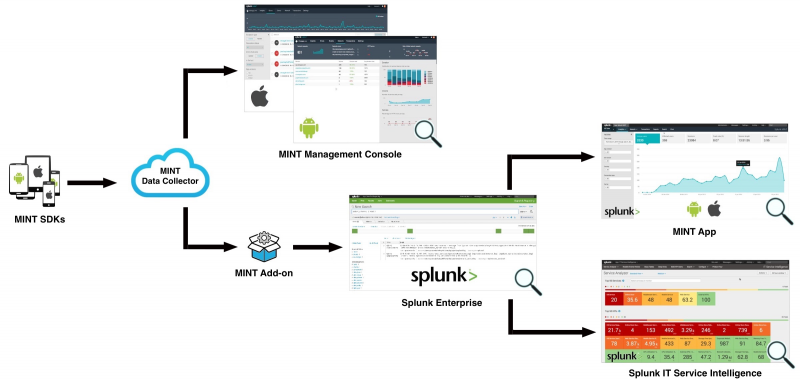About Splunk MINT
What is Splunk MINT?
Splunk MINT extends Splunk operational intelligence to your mobile applications, allowing you to deliver better-performing, more reliable apps. Splunk MINT provides mobile intelligence across all of your mobile app releases in production, across different types of devices on multiple operating systems.
With Splunk MINT you can:
Find the root causes of crashes and poor app performance
- Find out which errors are occurring the most by OS, device, and app version.
- Determine what were users were doing when a crash occurred.
- View the stack trace and instance occurrences for specific errors.
- Capture LogCat and NSLog output from your devices.
View network information to analyze your system capacity
- Measure latency, volume, and status codes for all HTTP calls.
- Monitor specific events and transactions.
- Filter information by connection type and carrier.
Follow end-to-end processes in your mobile apps to understand the user experience
- Report custom-defined events in your apps.
- Use transactions to follow specific tasks from start to finish.
- Add breadcrumbs to your crash reports to indicate when specific actions occur.
Get insights about the usage of your mobile apps
- Learn which platforms and devices are being used most.
- Find out how are your apps are performing on each OS and device.
- See how many users are affected by errors.
- Gain insight on usage and performance by users' locations.
- Correlate the performance and usage of your apps across mobile devices, web, and other channels.
How does Splunk MINT work?
Splunk MINT has several components that work together:

- The MINT SDKs integrate MINT into your mobile apps with only one line of code. The SDKs are available for several platforms.
- The MINT Data Collector forwards data from mobile apps to the MINT Management Console and the MINT Add-on for Splunk Enterprise.
- The cloud-based MINT Management Console shows you seven days of information about crashes, usage, and performance for each individual MINT project (a MINT project corresponds to one mobile app on one platform).
- The MINT Add-on collects data about your mobile app projects from the MINT Data Collector and sends it to Splunk Enterprise.
- The MINT App for Splunk Enterprise provides dashboards, saved reports, and search functionality allowing you to view data for all of your MINT app projects together, over all time, to gain powerful insights about all channels of your organization. For a comparison, see What's the difference between the Splunk MINT Management Console and the Splunk MINT App?
- The End User Experience Monitoring (EUEM) module for Splunk IT Service Intelligence (ITSI) monitors metrics related to the end-user experience and correlates end-user performance issues such as page load time, page rendering time, error rates, and AJAX latency.
How do I monitor mobile apps with Splunk MINT?
- Get a Splunk MINT account.
- Get the Splunk MINT SDKs.
- Create projects for your mobile apps in Splunk MINT Management Console.
- Integrate MINT into your mobile apps.
- View data for your mobile apps in MINT Management Console.
- Set up the Splunk MINT Add-on to pull data from the MINT Data Collector.
- View your MINT data in Splunk Enterprise.
- Run searches directly in Splunk Enterprise using the Search & Reporting app.
- Use the Splunk MINT App.
- Use the End User Experience Monitoring (EUEM) module for Splunk IT Service Intelligence (ITSI).
For each platform your app runs on, download the corresponding Splunk MINT SDK or plugin:
Log in to Splunk MINT Management Console and create a project for one variation of your mobile app (a platform and release stage, such as Android/Testing, or iOS/Release). You'll get an API key and a line of code to add for that particular platform—copy it to your clipboard:
Paste the line of code that contains your API key into your mobile app code to integrate MINT:
Repeat steps 3-4 for each of the mobile apps you want to monitor, creating one project for each platform/release stage combination.
When you start using your mobile apps, they will begin to send data to the Splunk MINT Data Collector. Go back to MINT Management Console and open your mobile app projects. You'll start to see data appear in your dashboards in minutes.
On your indexers and forwarders, install the MINT Add-on. On your forwarders, set the MINT Data Collector token.
Once your MINT data is indexed in Splunk Enterprise, you can view your data in different ways:
What are the keys and tokens used by MINT?
The following table summarizes the different keys and tokens used by Splunk MINT.
| Name | What is it? | Where is it? |
|---|---|---|
| API key | Identifies a specific mobile app project and is generated for each new project you create in Splunk MINT Management Console. | On the MINT Management Console home page, one key per project. |
| API token | Identifies your Splunk MINT account, and is used to provide authentication when integrating third-party apps such as HipChat or when using the dSYM uploader script. | In MINT Management Console, under Account > Account Info. |
| MINT Data Collector token | Connects your Splunk MINT account to Splunk Enterprise and enables iOS stack traces to be symbolicated in the MINT App. | In MINT Management Console, under Account > Usage. |
| HEC token | Enables you to use the HTTP Event Collector with MINT. | In Splunk Web, under Settings > Data inputs. |
Where can I get help?
- See the MINT documentation for more information about MINT Management Console, the Splunk MINT App, and the Splunk MINT SDKs.
- See Splunk Answers for community support or ask your question there.
| About Splunk MINT data collection |
This documentation applies to the following versions of Splunk MINT™ (EOL): 1.0

 Download manual
Download manual
Feedback submitted, thanks!